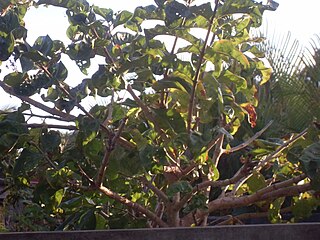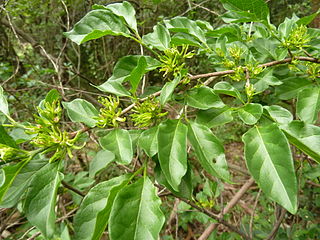
Canthium is a genus of flowering plants in the family Rubiaceae. They are shrubs and small trees. The leaves are deciduous and the stems are usually thorny.
Vangueria pallidiflora is a species of flowering plant in the family Rubiaceae. It is endemic to Kenya and Tanzania.

Lagynias was a genus of flowering plants in the family Rubiaceae but is no longer recognized. In 2005, it was sunk into synonymy with Vangueria, based on a phylogenetic study of DNA sequences.
Robynsia is a monotypic genus of flowering plants in the family Rubiaceae. It was described by John Hutchinson and was named after his friend and colleague Walter Robyns. The genus contains only one species, Robynsia glabrata, which is found in Ghana, Ivory Coast and Nigeria. The species is morphologically similar to the genus Cuviera but differs by having long, slender corolla tubes.
Vangueria induta is a species of flowering plant in the family Rubiaceae. It is found in Kenya and northern Tanzania.
Vangueria schliebenii is a species of flowering plant in the family Rubiaceae. It is endemic to Tanzania.
Vangueria bicolor is a species of flowering plant in the family Rubiaceae. It is endemic to Tanzania.

Vangueria is a genus of flowering plants in the family Rubiaceae. The genus is named for Voa vanguer, as V. madagascariensis is known in Malagasy.

Vanguerieae is a tribe of flowering plants in the family Rubiaceae and contains about 640 species in 28 genera. It is one of the most species-rich groups within the family and it is distributed all over the Paleotropics.

Fadogia is a genus of flowering plants in the family Rubiaceae. The genera Rytigynia and Fadogia form a strongly supported clade but neither of these genera is monophyletic.

Vangueria madagascariensis, commonly known by the names Spanish-tamarind, tamarind-of-the-Indies, or voa vanga, is a species of flowering plant in the family Rubiaceae native to the African continent having edible fruit. It is the type species of the genus Vangueria and was described in 1791 by Johann Friedrich Gmelin.
Ancylanthos was a genus of flowering plants in the family Rubiaceae but is no longer recognized. It was originally described by René Louiche Desfontaines in 1818. In 2005, it was sunk into synonymy with Vangueria, based on a phylogenetic study of DNA sequences.

Pachystigma was a genus of flowering plants in the family Rubiaceae but is no longer recognized. In 2005, it was sunk into synonymy with Vangueria, based on a phylogenetic study of DNA sequences.
Vangueria venosa is a species of flowering plant in the family Rubiaceae. It is found in Mozambique, Eswatini and the former Transvaal region.
Vangueria apiculata is a species of flowering plant in the family Rubiaceae. It is found from Ethiopia to South Tropical Africa.
Vangueria burttii is a species of flowering plant in the family Rubiaceae. It is endemic to Tanzania. It was described by Bernard Verdcourt in 1981 and is named after the English botanist Brian Burtt.
Vangueria chariensis is a species of flowering plant in the family Rubiaceae. It is endemic to southeastern Chad. It is named after the Chari river.
Vangueria coerulea is a species of flowering plant in the family Rubiaceae. It is endemic to Eswatini and the former Transvaal Province.

Vangueria cyanescens, commonly known as the Kalahari wild-medlar, is a species of flowering plant in the family Rubiaceae. It is found in Angola, Botswana, Namibia, and Zambia. The epithet is a Latin adjective meaning dark or deep blue, referring to the colour of the leaves, especially after drying.

Vangueria pygmaea is a species of flowering plant in the family Rubiaceae.








